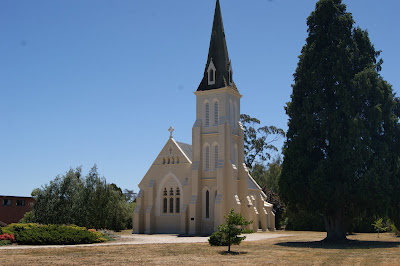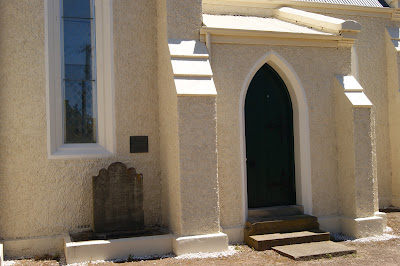The present building is the third to be built on the site. The first was a small chapel measuring 40 ft by 20ft with low walls and shingle roof and stood in paddocks close to the gates at the end of Church Lane. The chapel officially opened on February 18th, 1837 by the Lieutenant Governor Sir John Franklin. On week days the building served as a schoolroom. In October 1838, the residents of Evandale became anxious for a larger Church of England. With James Cox of Clarendon acting as their spokesman, 88 members of the congregation signed a petition requesting Government aid in the erection of a more suitable building.
Work began on the new church in 1841. It was a red brick building with a square tower at the western end, in the style of the present church at Campbell Town. The building was completed around 1844. By 1869, large cracks were observed, due to faulty foundations, and the church was ultimately pulled down in 1871. In 1868, the old chapel/schoolroom was the venue for the first Evandale Show. When the church was finally completed, the chapel was used as a Sunday school until it was demolished around 1910.
The foundation stone for the present building was laid on 30th November 1871 on the site of the 1844 church building and used many of the old bricks. Measuring 70ft by 25ft, the building was completed in 5 months by J & T Gunn of Launceston. It was their first major project. The bishop’s chair is made from timbers from Australia’s first warship, HMAS Nelson.
When the new St Andrew’s Church was consecrated, dedicated and opened on May 17th, 1872, the most admired part of the new building was the beautiful spire. The 108ft high spire had been added, mainly through the generosity of John Whitehead of Nile. It was considered by some at the time to be an extravagant waste of money and unnecessary and it became known as “Whitehead’s Folly” We can now appreciate John Whitehead’s forethought and good taste in helping to build the beautiful “Wedding Cake Church” as we see it today.
The adjacent cemetery is surrounded by ornamental cast iron railings. The cemetery contains the graves of people associated with the local community and the colonies. This includes the vault of James Cox, historically interesting to this district and NSW (Cox of Blue Mountains), the tomb of David Collins - first settler at Evandale and also Capt Barclay's smaller vault and tombs of local people.
Main Text & Information Source –
Evandale Heritage Walk brochure – The Evandale Community Centre
Australian Heritage Database
Historic Photos –











